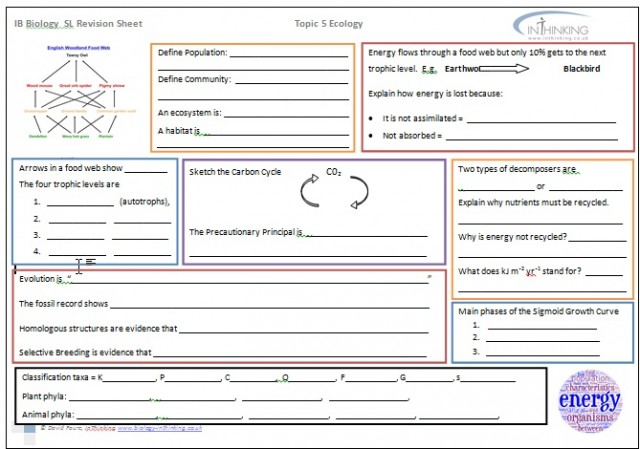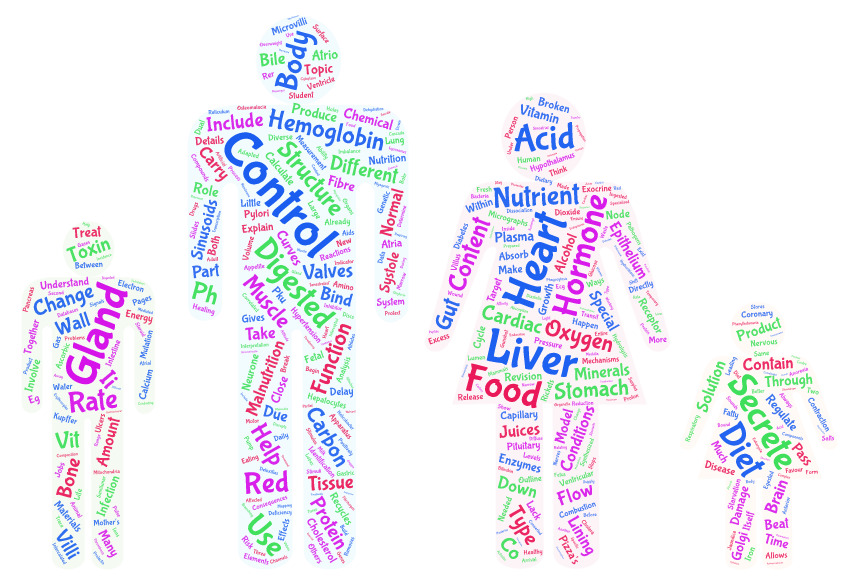Option D - Human Physiology Revision activities
 This page contains some suggestions for revision. To see the big picture, an overview of the whole option, the A3 revision sheets on this page will help. There are two revision sheets, one for the SL core material and a supplimentary page for the additrional HL material. Completing short questions or cloze activities students are forced to review the whole topic and in doing so prepare an overview of the main concepts in the topic.
This page contains some suggestions for revision. To see the big picture, an overview of the whole option, the A3 revision sheets on this page will help. There are two revision sheets, one for the SL core material and a supplimentary page for the additrional HL material. Completing short questions or cloze activities students are forced to review the whole topic and in doing so prepare an overview of the main concepts in the topic.
The revision list helps students to check that they have dovered all the details, and gives a tool to help identify areas in need of extra revision and a checklist of understandings and skills to learn. The revision list indicates those areas which are additional HL topics.
Description
Lesson starter.
Brainstorm the topic as a whole class. Keep notes of key ideas.
The image below may prompt ideas.
Activity 1 - A3 Revision worksheet
Complete the ![]() A3 revision worksheet for option D HL topic
A3 revision worksheet for option D HL topic
This includes unfinished phrases and missing words about the topic.
Use your lesson notes, and IB text books for help.
Avoid looking for answers on the internet as many answers will be too detailed, or too simple for your IB exams.
Remember this is just a beginning. There are many more details to understand and applications of these ideas to know.
Activity 2 - Revision list
The following list of understandings and essential questions for Option D can form the basis of revision work.
To do
Students read the understandings and the essential questions in the revision list page.
Students prepare an answer to one essential question - including details from the understandings section.
Students can then compare their answers with others in the class and either;
- add improvements - if one answer has a detail missing from the other.
- look up specific details - if both students are unclear
- ask the teacher a question - if there is a disagreement
Option D - Human physiology - SL Revision list
This pages gives outline details of the content of option D for SL students. There are essential questions and lists of student skills and applications. Helpful for revision. Student can check their understanding...
Option D - Human physiology HL revision list
This pages gives outline details of the content of option D for HL students. There are essential questions and lists of student skills and applications. Helpful for revision. Student can check their understanding...
Activity 3 - Physical space memory race
In this activity students use the answers from activity 2.
At one side of the room there are "essential questions" and at the other side students each have a piece of paper, "their answer sheet".
The aim is to complete answers a rapidly as possible by looking up details for an answer and transfering this to the 'answer sheet' using memory, Taking the model answer across the room is not allowed.
The dilemma is to decide how much to remember at a time before crossing the room.
To Do
- Students work individually.
- Students first sit in their place for 5 minutes (like IB exam reading time) and study a series of essential questions, trying to remember one or several of the questions. Good revision techniques help here, students looking for links, identifying easy or difficult questions, etc. will be "winners".
- Then the 'race' begins and students move to the other side of the room to look at the model answers to the questions they have memorised.
- Everyone chooses their own strategy. One question at a time is effective and reduces mistakes.
Two or three questions at a time is faster, but more risky. - The 'winner' is the first to complete all the answers correctly.
(Of course everyone is a winner if they have learned some biology during the lesson)
Activity 4 - Corrections & Improvement
Students compare answers with other students & use the model answers (coming soon).
Make improvements to the answers and note any areas which are less well understood and require further revision.
Teachers notes
This activity is aimed at those students who need help to make their revision effective, but it is useful for all students. The three short activities are really just suggestions.
The worksheet could be a simple homework task.
Suggested lesson plan.
Starter (10 minutes)
Brainstorm the topic asking students to recall as many parts of the topic as they can.
Record these on the whiteboard.
Main (30 minutes)
Students use their text books and notes to complete the unfinished phrases on the worksheet.
Students compare their answers to the model answers provided.
Plenary (20 minutes)
The Connect extend, challenge activity could be combined with a memorizing activity.
It should help the students to make links to their prior knowledge, and to identify areas to revise.
There are plenty of possibilities to enhance this activity. For example, write ideas on post-it notes and share them with the whole class or to work as a whole class around the interactive whiteboard.
Extension work
There are many possibilities for extension. Students could
- create a mind map of the topic
- produce lists of questions for a hot seat challenge
- make a revision presentation on one part of the topic
Alternative plenary - Hot Seat Challenge
Students set their own challenge to try to memorize parts of the sheet.
Students can begin using look cover test check for 5 points at a time, and gradually build up until they can remember the whole sheet.
When a student is chosen for the 'Hot Seat' they sit in the teachers chair, describe their area of expertise (ie. how much of the sheet they thing they know) and other students ask them as many questions as possible in one minute.

 IB Docs (2) Team
IB Docs (2) Team

